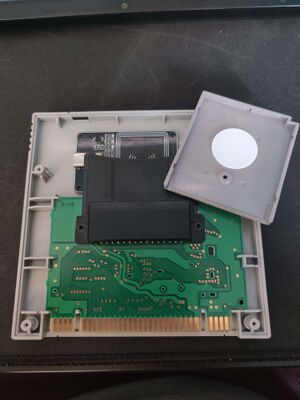Super TapTo Boy: Difference between revisions
No edit summary |
No edit summary |
||
| Line 1: | Line 1: | ||
Super TapTo Boy is the name of a custom case project where a Super Nintendo or Super Famicom shell (with a SBC inside) is used together with a Super Gameboy for reading the games. The Super Gameboy houses a PN532 NFC reader inside that is connected to a SBC (DE-10 Nano or Raspberry Pi) which itself is housed inside the Super Nintendo shell. They are then connected on the inside to each other via a wired USB connection. | Super TapTo Boy is the name of a custom case project where a Super Nintendo or Super Famicom shell (with a SBC inside) is used together with a Super Gameboy for reading the games. The Super Gameboy houses a PN532 NFC reader inside that is connected to a SBC (DE-10 Nano or Raspberry Pi) which itself is housed inside the Super Nintendo shell. They are then connected on the inside to each other via a wired USB connection. | ||
[[File:Logo Printable.png|thumb|Super TapTo Boy Logo]] | |||
The games' path is written on a NFC chip or tag via the TapTo Life app and then adhered on the inside of a GameBoy cartridge that is subsequently read by the NFC reader which sits inside the Super GameBoy. This will in turn start the game on the desired hardware. You can find more information on how to use the TapTo Life app to write games to NFC chips [https://tapto.wiki/Getting_Started here]. | The games' path is written on a NFC chip or tag via the TapTo Life app and then adhered on the inside of a GameBoy cartridge that is subsequently read by the NFC reader which sits inside the Super GameBoy. This will in turn start the game on the desired hardware. You can find more information on how to use the TapTo Life app to write games to NFC chips [https://tapto.wiki/Getting_Started here]. | ||
== Introduction == | == Introduction == | ||
[[File:Sgb inside.jpg|thumb|Inside of a Super TapTo Boy]] | |||
This project started it's life after contemplating on how best to use physical media together with sofware or hardware emulation. Since the MiSTer Project and the multitude of Linux-based Emulation systems have no physical media to speak of for games, a lot of people resort to using their own classic consoles for the most nostalgic looking and feeling experience. Since nowadays software and hardware emulation has come a long way and (almost) become interchangable with original hardware for accuracy on some cores, the abscence of physical media keeps people from viewing this route as a 'complete' experience. | This project started it's life after contemplating on how best to use physical media together with sofware or hardware emulation. Since the MiSTer Project and the multitude of Linux-based Emulation systems have no physical media to speak of for games, a lot of people resort to using their own classic consoles for the most nostalgic looking and feeling experience. Since nowadays software and hardware emulation has come a long way and (almost) become interchangable with original hardware for accuracy on some cores, the abscence of physical media keeps people from viewing this route as a 'complete' experience. | ||
Revision as of 14:36, 21 July 2024
Super TapTo Boy is the name of a custom case project where a Super Nintendo or Super Famicom shell (with a SBC inside) is used together with a Super Gameboy for reading the games. The Super Gameboy houses a PN532 NFC reader inside that is connected to a SBC (DE-10 Nano or Raspberry Pi) which itself is housed inside the Super Nintendo shell. They are then connected on the inside to each other via a wired USB connection.

The games' path is written on a NFC chip or tag via the TapTo Life app and then adhered on the inside of a GameBoy cartridge that is subsequently read by the NFC reader which sits inside the Super GameBoy. This will in turn start the game on the desired hardware. You can find more information on how to use the TapTo Life app to write games to NFC chips here.
Introduction

This project started it's life after contemplating on how best to use physical media together with sofware or hardware emulation. Since the MiSTer Project and the multitude of Linux-based Emulation systems have no physical media to speak of for games, a lot of people resort to using their own classic consoles for the most nostalgic looking and feeling experience. Since nowadays software and hardware emulation has come a long way and (almost) become interchangable with original hardware for accuracy on some cores, the abscence of physical media keeps people from viewing this route as a 'complete' experience.
The TapTo project introduces a new way for people to fill this gap with physical NFC cards. Super TapTo tries to improve upon this concept again with physical cartridges to replicate the feeling inserting games and having a classic console while keeping the cost relatively low compared original hardware.